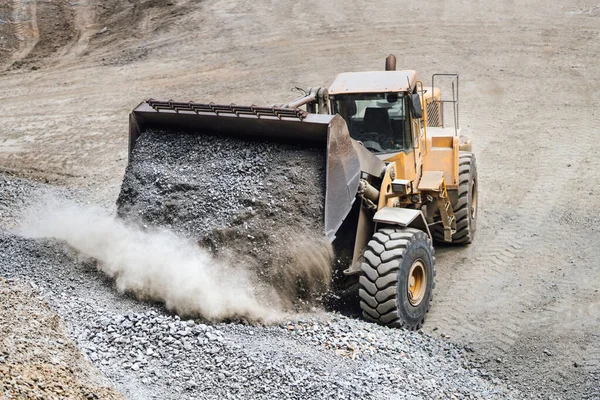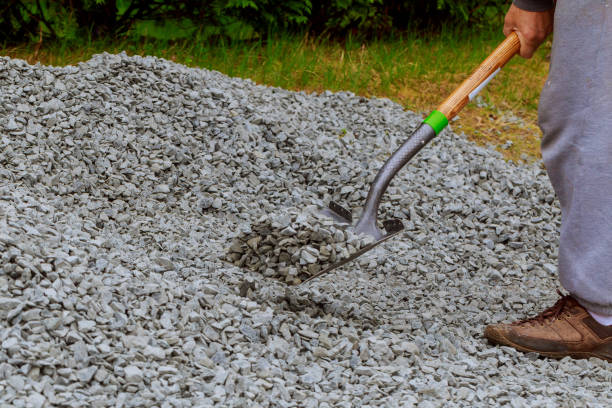Gravel, a versatile and widely used material, plays a vital role in numerous industries and projects.
Whether construction, landscaping, or road maintenance, gravel provides stability, drainage, and aesthetics.
In construction, it serves as a key component in concrete and base material for roads and driveways.
And in landscaping, it adds texture and visual appeal to gardens and pathways.
However, one question that often arises is: How long does it take to move a ton of gravel?
Read on to discover the answer to this ‘puzzle’.
How Long to Move a Ton of Gravel
Moving a ton of gravel involves various factors that influence the time required for transportation.
While it’s challenging to provide an exact time frame, we can consider average estimates based on common scenarios.
Keep in mind that these estimates can vary depending on the specific circumstances of your project.
Distance and transportation method
For shorter distances (within a few miles), using dump trucks or trailers, the transportation time can range from 30 minutes to 1 hour per ton of gravel.
If the distance increases, involving longer trips or alternative transportation methods like conveyor belts, the time may extend to 1-2 hours per ton.
Equipment and machinery used
Larger trucks and trailers with higher capacity can move more gravel per trip, reducing the overall time required.

With efficient equipment, the time to move a ton of gravel can be around 20-30 minutes.
Workforce and efficiency
The number and efficiency of workers involved play a significant role.
On average, a well-trained team can load and unload approximately 10-15 tons of gravel per hour, which translates to around 4-6 minutes per ton.
Site accessibility and terrain conditions
Difficult terrains, limited access, or challenging site conditions can increase the time needed for transportation. It’s essential to consider these factors when estimating the overall time.
Related: Best Equipment to Move Large Rocks
How to Estimate the Time Required to Move a Ton of Gravel
Estimating how long it will take to move a ton of gravel involves a systematic approach considering various factors. Here’s a detailed explanation of each step.
Calculate the volume of gravel
Start by measuring the length, width, and depth of the area you want to cover with gravel.
Multiply these dimensions together to calculate the volume in cubic units (e.g., cubic feet or cubic meters).
This calculation will provide you with an idea of the amount of gravel that needs to be transported.
Determine the speed and capacity of transportation equipment

Different equipment types have varying speeds and load capacities. For instance, dump trucks may have different load capacities, such as 10 cubic yards or 20 tons.
Research and identify the specific speed and capacity of the equipment you’ll be using.
Once you have this information, you can estimate the number of trips required to move the total volume of gravel.
Divide the total volume by the capacity of the transportation equipment to calculate the number of trips needed.
Multiply this by the average speed of the equipment to estimate the time required for transport.
Consider loading and unloading time
Loading the gravel onto the transportation equipment and unloading it at the destination requires additional time.
Efficient loading and unloading processes contribute to minimizing the overall transportation time.
Consider factors such as the availability and efficiency of loaders or conveyor systems during the loading process.
Similarly, account for the time required to unload the gravel at the destination.
It’s essential to assess the loading and unloading processes specific to your project.
This may involve coordinating with the equipment operators and ensuring optimal workflow to minimize any potential delays.
Evaluate the impact of environmental factors
Traffic congestion, road conditions, and adverse weather conditions can all affect the overall time required.
Consider the route you’ll be taking and assess the potential challenges posed by traffic patterns or road conditions. Incorporate additional time buffers if you anticipate delays due to these factors.
Weather conditions can also impact transportation time. Rainy or snowy weather may slow down transport due to reduced traction or slippery road surfaces.
Be prepared for such weather-related delays and adjust your time estimation accordingly.
Related: Mexican Landscapers: All You Need to Know
4 Ways to Move Gravel Effectively
There are several methods commonly used for moving gravel.

1. Dump trucks and trailers
These are widely used in gravel transportation due to their versatility and capacity.
They’re capable of carrying large quantities of gravel in a single trip, which makes them efficient for transporting significant volumes over shorter distances.
The dump bed allows for easy unloading at the destination, minimizing manual labor and speeding up the process.
This method is commonly employed in construction sites, road maintenance projects, and landscaping endeavors.
2. Conveyor belts and loaders
Conveyor belts offer an effective solution for long-distance gravel transportation, especially in cases where access by trucks may be limited or impractical.
They provide a continuous flow of gravel that eliminates the need for multiple trips by vehicles.
Loaders are often used to load gravel onto the conveyor belts, streamlining the process and reducing manual labor.
Conveyor belts can transport gravel over varying terrains, including uneven surfaces or steep slopes. This makes them a versatile option for efficient gravel movement.
Related: 5 Best Ways to Move River Rock by Hand
3. Gravel bags and manual labor
For smaller-scale projects or areas with limited access, gravel bags can be an effective transportation method.
Gravel is filled into bags and manually carried to the desired location.
While this method may require more time and physical effort compared to using machinery, it offers flexibility and ease of use, especially in situations where other transportation options are not feasible.
Gravel bags are commonly used in gardening and landscaping projects, where precise placement of gravel is desired.
4. Innovative techniques and emerging technologies
Advancements in technology are continuously shaping the field of gravel transportation.
Automated conveyor systems, for example, offer increased efficiency and reduced manual labor.
These systems can be programmed to transport gravel automatically, eliminating the need for constant human intervention.
Self-driving vehicles are being explored as a potential solution for gravel transportation, with the potential to improve efficiency, safety, and overall time required.
These emerging technologies have the potential to revolutionize the gravel transportation industry and make it more streamlined and cost-effective.
Related
- Shadow Box Fence Pros and Cons
- Shadow Box Fence Vs Board on Board Fence (Side by Side Comparison)
- Best Paslode Framing Nailers Review
- Top 5 Freeman Framing Nailers Review
- Best Numax Finish & Framing Nailers Review
- 8 Best Metabo Framing Nailers Review
- Monument Grills Vs Weber Grills Review
- Advantages and Disadvantages of Dog Eared Fence
- How to Clean Lava Rock Landscaping: Simple Steps to Try
- How to Clean Limestone Landscape Rocks (Step by Step)
- 5 Best Ways to Move River Rock by Hand (Simple Tips)


